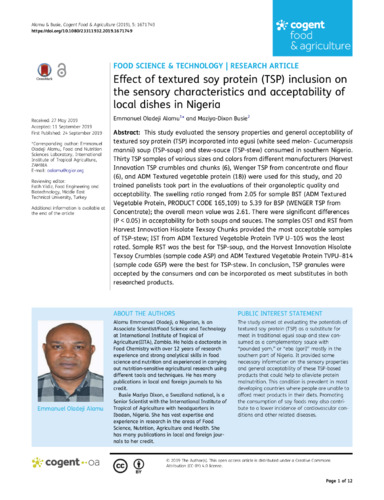Effect of textured soy protein (TSP) inclusion on the sensory characteristics and acceptability of local dishes in Nigeria
Abstract
This study evaluated the sensory properties and general acceptability of textured soy protein (TSP) incorporated into egusi (white seed melon- Cucumeropsis mannii) soup (TSP-soup) and stew-sauce (TSP-stew) consumed in southern Nigeria. Thirty TSP samples of various sizes and colors from different manufacturers (Harvest Innovation TSP crumbles and chunks (6), Wenger TSP from concentrate and flour (6), and ADM Textured vegetable protein (18)) were used for this study, and 20 trained panelists took part in the evaluations of their organoleptic quality and acceptability. The swelling ratio ranged from 2.05 for sample BST (ADM Textured Vegetable Protein, PRODUCT CODE 165,109) to 5.39 for BSP (WENGER TSP from Concentrate); the overall mean value was 2.61. There were significant differences (P < 0.05) in acceptability for both soups and sauces. The samples OST and RST from Harvest Innovation Hisolate Texsoy Chunks provided the most acceptable samples of TSP-stew; IST from ADM Textured Vegetable Protein TVP U–105 was the least rated. Sample RST was the best for TSP-soup, and the Harvest Innovation Hisolate Texsoy Crumbles (sample code ASP) and ADM Textured Vegetable Protein TVPU–814 (sample code GSP) were the best for TSP-stew. In conclusion, TSP granules were accepted by the consumers and can be incorporated as meat substitutes in both researched products.

